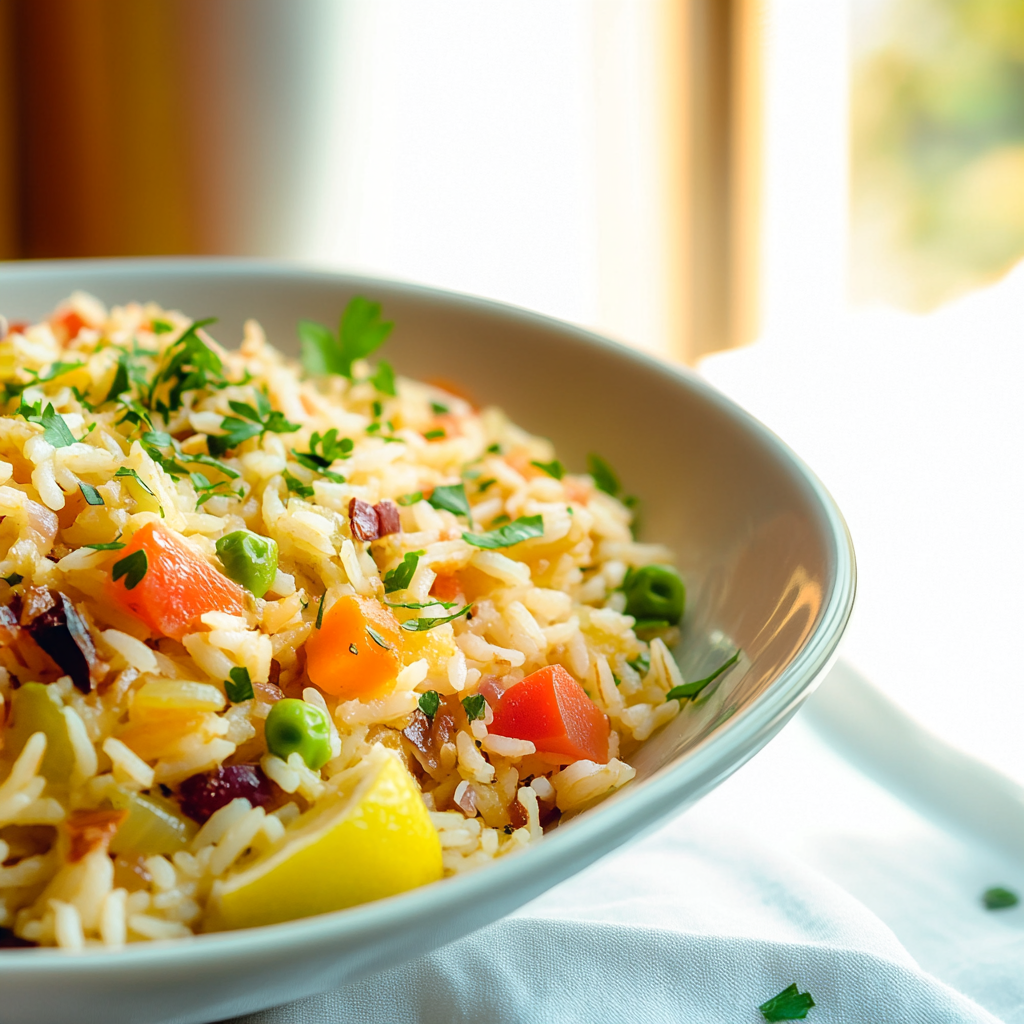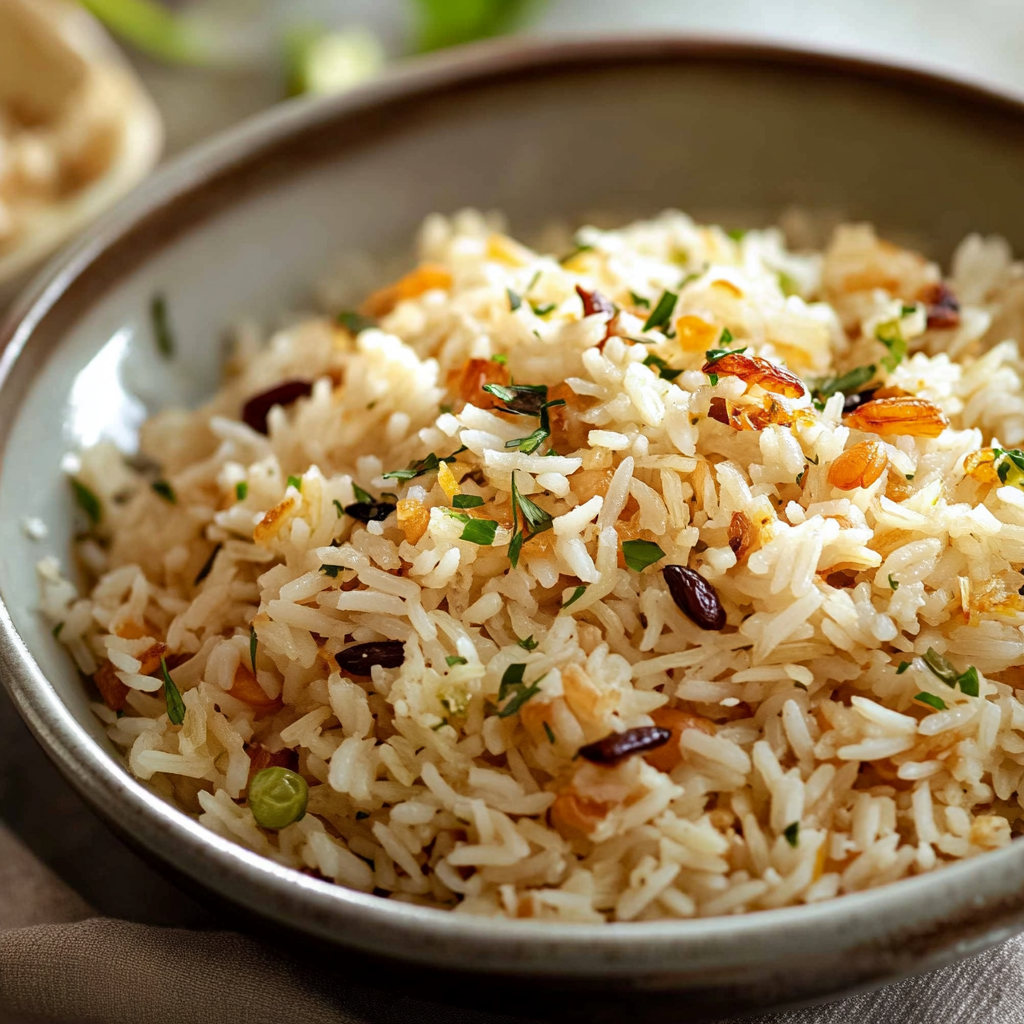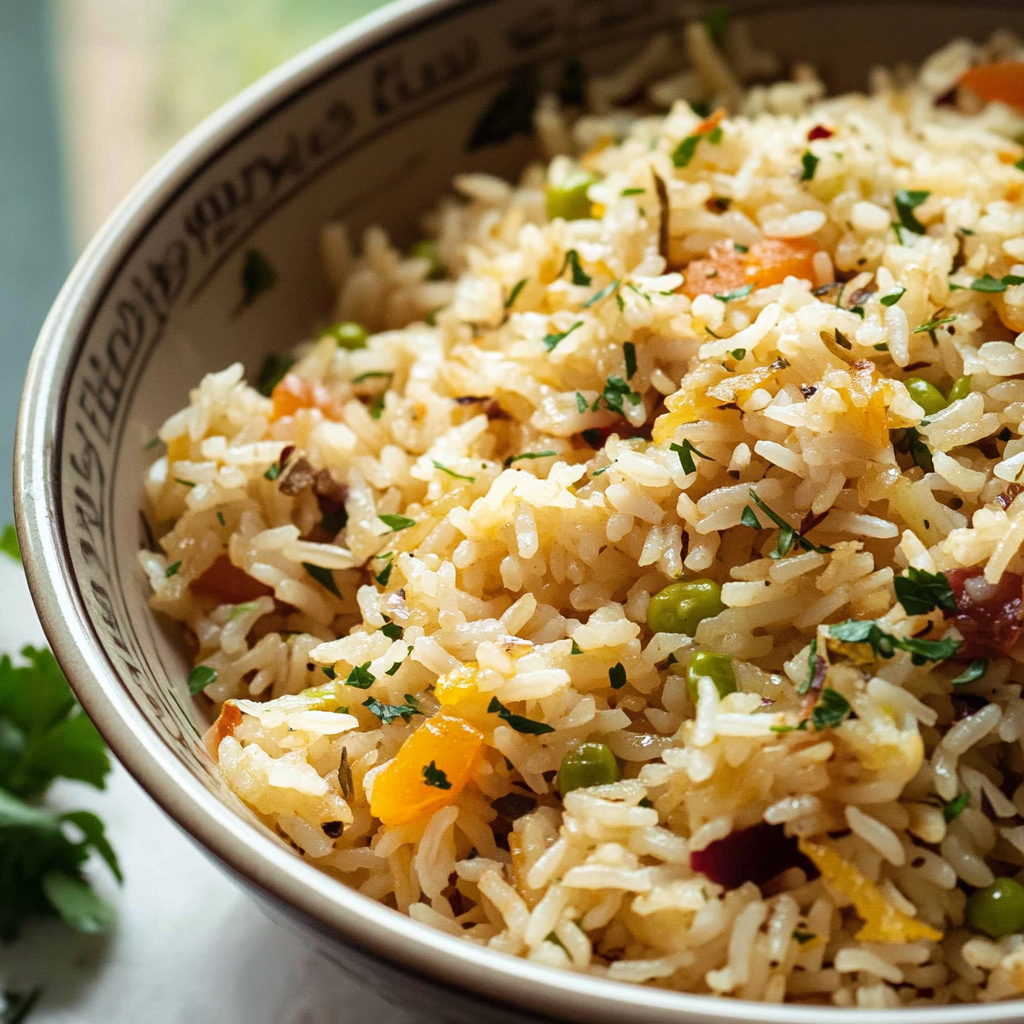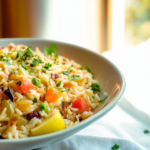Have you ever tasted a dish that feels like a warm hug on a cold day? Rice pilaf is one such dish, brimming with flavors and textures that come together beautifully. The fragrant aroma of sautéed onions combined with perfectly cooked grains creates an inviting experience that beckons you to the table.

This delightful recipe not only satisfies your hunger but also elevates any meal. Whether served as a side dish for family gatherings or as a comforting centerpiece for a cozy dinner, rice pilaf promises to impress. Get ready to indulge in its rich taste and simple preparation!
Why You’ll Love This rice pilaf
Versatile Side Dish: Rice pilaf pairs wonderfully with various main courses like grilled chicken, roasted vegetables, or seafood. Its adaptability makes it perfect for any dining occasion, whether casual or formal.
Easy to Prepare: With just a handful of ingredients and straightforward steps, this recipe allows even novice cooks to shine in the kitchen. You can whip up this dish in under 30 minutes while impressing your guests.
Aromatic Flavor Profile: The combination of spices and sautéed onions infuses the rice with an enticing aroma and flavor. Each bite is a delightful experience that transforms plain rice into something extraordinary.
Nutritious Option: Packed with vitamins from vegetables and whole grains if you choose brown rice, this dish is not only delicious but also contributes positively to your diet. Enjoy guilt-free indulgence with every serving.
Ingredients
Here’s what you’ll need to make this delicious dish:
Long-Grain Rice: Use basmati or jasmine rice for the best flavor and texture. Rinse it well before cooking to remove excess starch.
Chicken or Vegetable Broth: Opt for low-sodium broth for better control over the saltiness while enhancing the flavor of the rice.
Onion: A finely chopped yellow onion adds sweetness and depth. Sauté until translucent for optimal flavor.
Garlic: Fresh minced garlic will elevate the taste profile of your pilaf with its aromatic punch.
Butter or Olive Oil: Choose unsalted butter or high-quality olive oil to add richness without overpowering the other flavors.
The full ingredients list, including measurements, is provided in the recipe card directly below.
How to Make rice pilaf
Follow these simple steps to prepare this delicious dish:
Prep Your Ingredients: Start by gathering all your ingredients. Rinse the long-grain rice under cold water until the water runs clear. Chop your onion and mince your garlic finely.
Sauté Aromatics: In a large saucepan over medium heat, melt 2 tablespoons of butter (or heat olive oil). Add the chopped onion and sauté until it turns translucent—about 3-4 minutes—then stir in the minced garlic and cook for another minute until fragrant.
Add Rice: Pour in the rinsed long-grain rice into the saucepan. Stir well to coat each grain with butter or oil. Toast the rice for about 2-3 minutes until it becomes slightly golden.
Pour in Broth: Carefully add 4 cups of chicken or vegetable broth into the saucepan along with salt and pepper to taste. Stir briefly and bring everything to a gentle boil.
Simmer Until Cooked: Reduce heat to low once boiling, cover tightly with a lid, and let simmer for 18-20 minutes without lifting the lid. This allows steam to cook the rice perfectly without becoming mushy.
Fluff and Serve: After cooking time is complete, remove from heat but keep covered for an additional 5 minutes. Then fluff gently with a fork before serving as a delightful side dish!

Tips and Tricks
Here are some helpful tips to ensure the best results for your dish:
Rinse Your Rice: Always rinse your rice before cooking it; this removes excess starch that can cause it to become sticky during cooking.
Adjust Liquid Ratios: If using brown rice instead of white, increase broth quantity by about half a cup since brown rice requires more liquid due to its outer bran layer.
Add Vegetables for Color: Incorporate diced carrots or peas into your pilaf during cooking for added nutrition and vibrant color; they’ll enhance both appearance and flavor!
Cilantro Garnish: For an extra pop of freshness, sprinkle chopped cilantro over your finished dish right before serving—it complements the flavors beautifully!
Leftovers Storage: Store leftover pilaf in an airtight container in the refrigerator for up to five days; simply reheat when ready to enjoy again!
With these easy tips at hand, you’re well on your way to mastering this timeless recipe!
Mistakes to avoid
Using the wrong rice type
Choosing the right type of rice is crucial for a perfect rice pilaf. Long-grain varieties like basmati or jasmine work best, as they remain fluffy and separate when cooked. Avoid using short-grain rice, which tends to clump together and become sticky. Always read the package instructions, as different rice types may require varying water ratios and cooking times. For best results, rinse the rice under cold water before cooking to remove excess starch and prevent stickiness.
Skipping the sauté step
Many home cooks overlook the importance of sautéing the rice before boiling it. This step enhances flavors by lightly toasting the grains in butter or oil, creating a nutty aroma. Sauté for about 3-5 minutes until the rice turns slightly golden. This technique also helps to keep the rice from becoming mushy during cooking. Ignoring this step can lead to an underwhelming flavor profile that lacks depth.
Not measuring liquid accurately
Precision is key when making rice pilaf. Using too much liquid can result in soggy rice, while too little will leave it undercooked. A general rule is to use a 2: 1 water-to-rice ratio for long-grain varieties. However, always check your specific rice’s instructions for exact measurements. When adding broth or stock for flavor, remember that these liquids already contain salt, so adjust your seasoning accordingly.
Overcooking the rice
Cooking time significantly impacts the texture of your rice pilaf. Overcooking can lead to mushy grains that lose their desired fluffiness. Follow package instructions closely; most long-grain rices require about 15-20 minutes of simmering after bringing them to a boil. Once you turn off the heat, let the pilaf sit covered for an additional 5-10 minutes to allow steam to finish cooking without direct heat exposure.
Neglecting seasoning and aromatics
Flavor is essential in a delicious rice pilaf. Many cooks forget to add sufficient seasoning during cooking, leading to bland results. Enhance your dish with aromatics such as onions, garlic, or herbs like bay leaves and thyme. Sauté these ingredients along with your rice at the beginning for maximum flavor infusion. Don’t hesitate to experiment with spices like cumin or coriander for an extra kick.
Failing to fluff the rice after cooking
After allowing your rice pilaf to rest, it’s important to fluff it with a fork before serving. This process helps separate any grains that may have stuck together during cooking and enhances its overall appearance and texture. Skipping this step can result in clumpy pilaf that doesn’t look appealing on your plate. Fluffing takes just a minute but significantly improves presentation.
Ignoring resting time
Resting is often overlooked but plays a vital role in achieving perfect rice pilaf consistency. After cooking, allow your dish to sit covered for about 10 minutes before serving. This resting period lets excess moisture redistribute throughout the grains and prevents them from becoming overly wet or gummy when plated. It’s an easy step that makes a noticeable difference in texture.
Not customizing ingredients
Rice pilaf is versatile; don’t hesitate to customize it with various ingredients! Many people stick strictly to traditional recipes without exploring options like nuts, dried fruits, or vegetables. Try incorporating toasted almonds, raisins, or peas to add texture and flavor contrast. Personalizing your recipe not only enhances taste but also makes it visually appealing on the table.

FAQs
What is the best type of rice for making rice pilaf?
The best type of rice for making rice pilaf is long-grain varieties such as basmati or jasmine because they cook evenly and stay fluffy.
Can I use brown rice instead of white for my rice pilaf?
Yes, you can use brown rice instead of white; however, adjust cooking times as brown rice typically requires more water and longer cooking periods.
How do I prevent my rice pilaf from being sticky?
To prevent sticky rice pilaf, rinse your uncooked rice thoroughly until the water runs clear and sauté it before boiling with appropriate liquid ratios.
Is it necessary to soak my rice before making pilaf?
Soaking isn’t necessary but can improve texture by reducing cooking time and ensuring even hydration if you choose whole grain varieties.
Can I prepare my rice pilaf ahead of time?
Absolutely! You can prepare your rice pilaf ahead of time; just store it in an airtight container and reheat gently when ready to serve while adding a splash of water if needed for moisture.
Serving Suggestions
This rice pilaf is versatile and pairs wonderfully with grilled chicken. The savory flavors of the pilaf complement the charred, smoky taste of grilled meat. Serve the pilaf warm alongside a simple green salad for a balanced meal. You can also add a squeeze of fresh lemon over the chicken to enhance its flavor, making it an ideal dish for a summer barbecue or family gathering.
For a vegetarian option, consider serving rice pilaf with roasted vegetables. The nutty flavor of the pilaf balances beautifully with the sweetness of roasted carrots, bell peppers, and zucchini. Drizzle a bit of balsamic glaze over the veggies for added depth. This combination not only satisfies but also provides a colorful plate that is visually appealing and nutritious.
Rice pilaf works well as a side dish for fish. Whether you’re serving baked salmon or pan-seared tilapia, the lightness of the fish pairs nicely with the fluffy texture and aromatic spices of the pilaf. Incorporate herbs like dill or parsley to tie in flavors from both dishes. This pairing makes for an elegant dinner, perfect for entertaining guests.
Another delightful pairing is with lamb dishes. The rich, hearty flavors of braised lamb or grilled lamb chops harmonize with the delicate spices in rice pilaf. Consider adding dried fruits like apricots or raisins to your pilaf to echo the sweet notes often found in Mediterranean lamb recipes. This combination creates a memorable dining experience filled with robust flavors.

FAQs
What ingredients are essential for making rice pilaf?
The essential ingredients for rice pilaf include long-grain rice, broth (chicken or vegetable), onions, and butter or oil. You can also add seasonings such as garlic, bay leaves, and various herbs for enhanced flavor. The type of broth you use will significantly influence the overall taste of your rice pilaf.
Can I make rice pilaf in advance?
Yes, you can make rice pilaf in advance! It stores well in an airtight container in the refrigerator for up to three days. Reheat it gently on the stove with a splash of broth or water to restore its moisture before serving. This makes it a convenient option for meal prep or entertaining guests.
How can I customize my rice pilaf?
You can customize your rice pilaf by adding vegetables like peas, carrots, or bell peppers during cooking. Additionally, nuts such as almonds or pine nuts can provide texture and flavor. For protein-rich options, consider incorporating cooked chickpeas or diced chicken to make it more filling.
What is the best way to store leftover rice pilaf?
Store leftover rice pilaf in an airtight container in your refrigerator. It should be consumed within three days for optimal freshness. If you want to keep it longer, you can freeze it in portions; simply thaw and reheat when ready to enjoy again.
Conclusion
In conclusion, rice pilaf is a deliciously versatile dish that enhances any meal with its fragrant aroma and fluffy texture. By incorporating simple ingredients such as broth, onions, and spices, you can create a satisfying side that pairs well with many main courses like chicken, fish, or lamb. Customize your recipe by adding vegetables or nuts to enhance flavor and nutrition further. Whether served at family dinners or special gatherings, this dish will surely impress your guests while being easy to prepare ahead of time. Enjoy experimenting with different pairings and flavors as you make this delightful rice pilaf!

Easy and Flavorful Rice Pilaf Recipe
- Total Time: 30 minutes
- Yield: Serves 4
Description
Rice pilaf is a timeless dish that delights with its aromatic flavors and fluffy texture. This easy-to-make recipe combines long-grain rice, sautéed onions, and fragrant spices, creating a savory side that complements any meal. Whether served alongside grilled chicken or roasted vegetables, rice pilaf is versatile enough for casual dinners or special occasions. With just a few simple ingredients and straightforward steps, you can whip up this delicious dish in no time. Perfectly seasoned and rich in nutrients, it’s a wholesome addition to your culinary repertoire.
Ingredients
- 1 cup long-grain rice (basmati or jasmine)
- 2 tablespoons unsalted butter or olive oil
- 1 medium yellow onion, finely chopped
- 2 cloves garlic, minced
- 4 cups low-sodium chicken or vegetable broth
- Salt and pepper to taste
Instructions
- Rinse the rice under cold water until the water runs clear; set aside.
- In a large saucepan over medium heat, melt the butter or heat oil. Sauté the onion for 3-4 minutes until translucent, then add garlic and cook for another minute.
- Stir in the rinsed rice and toast for 2-3 minutes until slightly golden.
- Pour in the broth, season with salt and pepper, and bring to a gentle boil.
- Reduce heat to low, cover tightly, and simmer for 18-20 minutes without lifting the lid.
- After cooking, remove from heat and let it sit covered for an additional 5 minutes. Fluff gently with a fork before serving.
- Prep Time: 10 minutes
- Cook Time: 20 minutes
- Category: Side Dish
- Method: Sautéing
- Cuisine: Middle Eastern
Nutrition
- Serving Size: 1 cup (185g)
- Calories: 220
- Sugar: 1g
- Sodium: 450mg
- Fat: 6g
- Saturated Fat: 2g
- Unsaturated Fat: 4g
- Trans Fat: 0g
- Carbohydrates: 36g
- Fiber: 1g
- Protein: 5g
- Cholesterol: 10mg
Keywords: - Rinse rice thoroughly to prevent stickiness. - Feel free to add diced carrots or peas during cooking for added nutrition and color. - Leftover pilaf can be stored in an airtight container in the refrigerator for up to five days.
